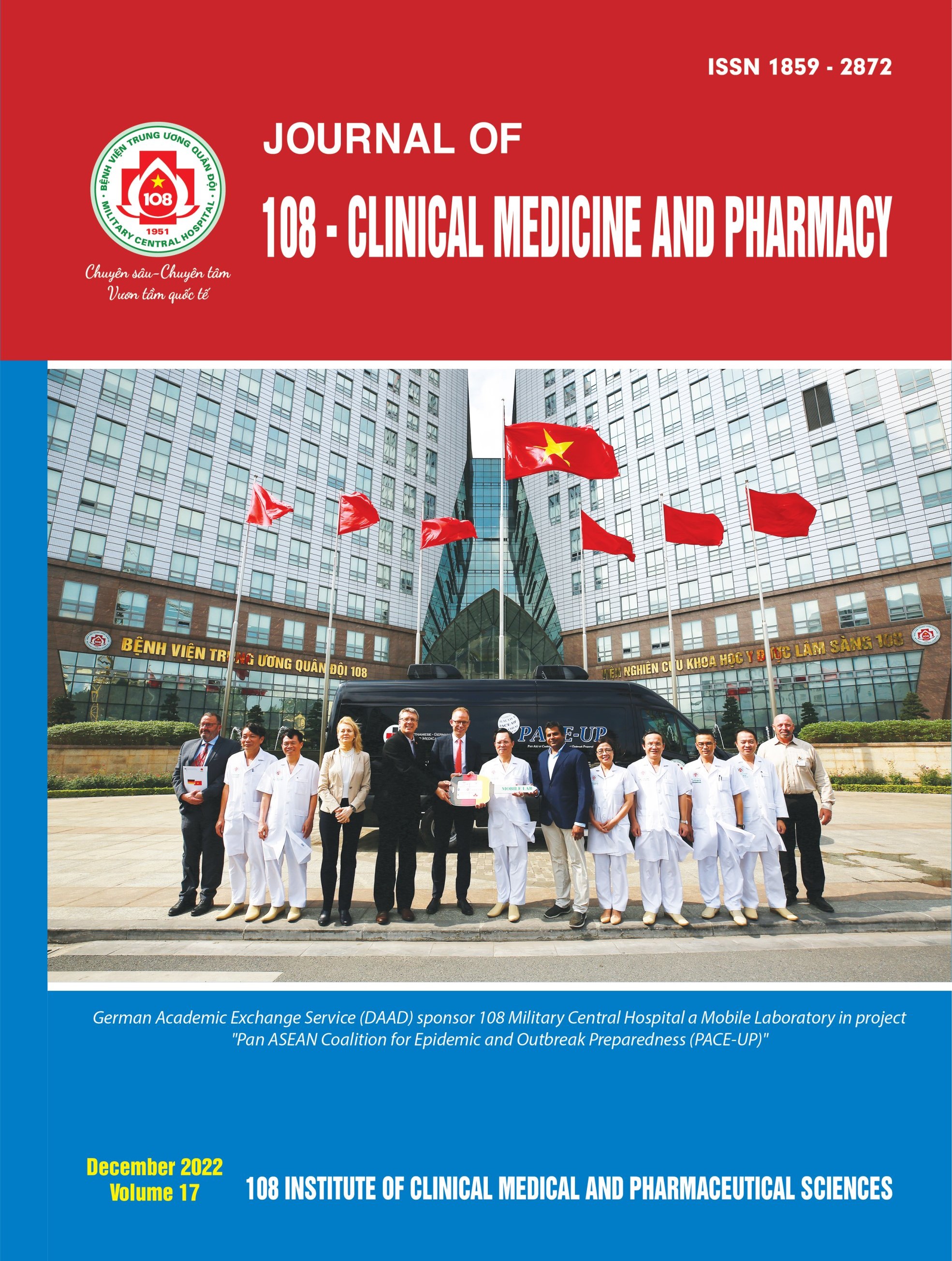Autologous hematopoietic stem cell transplantation to treat systemic lupus erythematosus: The first case in Vietnam
Main Article Content
Tóm tắt
Background: Systemic lupus erythematosus (SLE) is a chronic disease that causes systemic inflammation which affects multiple organs. There is no cure for SLE. Conventional treatment options include antimalarial drugs, corticosteroids, and immune suppressants, but a number of patients are resistant to treatment or suffer from severe side effects. Stem cell transplantation has been used to treat SLE for the past 2 decades. We describe the first Vietnamese patient with refractory SLE who received an autologous hematopoietic stem cell transplant. Case presentation: The patient is a woman who was diagnosed 12 years ago with systemic lupus erythematosus. She was administered corticosteroids and high-dose immunosuppressive medicines, but the condition was refractory, manifesting as severe headache, arthralgia, chronic anemia, severe Cushing's syndrome, and proteinuria. At admission, the SLEDAI score was 28 and proteinuria was 6.7g/l. She received cyclophosphamide and G-CSF for HSCT mobilization. Peripheral blood stem cells were collected and selected for CD34+ cells. Antithymocyte, cyclophosphamide, and rituximab were used in conditioning regimens. The patient was then administered a CD34+ autologous hematopoietic stem cell transfusion with a CD34+ dose of 7.93 x 106 cells/kg body weight, T and B lymphocyte purity of the graft exceeded 99.99%. Post-transplant course was favorable, the patient did not experience serious complications. Recovery of neutrophils on post-HSCT day +9 and platelet on day +12. Six months after stem cell transplantation, the patient's clinical symptoms significantly improved, the SLEDAI score dropped from 28 to 0, and the patient discontinued receiving immunosuppressive drugs. Conclusion: Autologous hematopoietic stem cell transplantation promises to be a new, effective therapeutic method that can be implemented more broadly in Vietnam for SLE patients.
Article Details
Các tài liệu tham khảo
2. Durcan L, O’Dwyer T, Petri M (2019) Management strategies and future directions for systemic lupus erythematosus in adults. Lancet Lond Engl 393(10188): 2332-2343. doi:10.1016/S0140-6736(19)30237-5
3. Gratwohl A, Baldomero H, Aljurf M et al (2010) Hematopoietic stem cell transplantation: A global perspective. JAMA 303(16): 1617-1624. doi: 10.1001/jama.2010.491.
4. Ayano M, Tsukamoto H, Mitoma H et al (2019) CD34-selected versus unmanipulated autologous haematopoietic stem cell transplantation in the treatment of severe systemic sclerosis: A post hoc analysis of a phase I/II clinical trial conducted in Japan. Arthritis Res Ther 21(1): 30. doi: 10.1186/s13075-019-1823-0.
5. Rovira M, Wulffraat NM, Kazmi M et al (2021) Evolution, trends, outcomes, and economics of hematopoietic stem cell transplantation in severe autoimmune diseases. Blood Adv 1(27): 2742-2755. doi: 10.1182/bloodadvances.2017010041.
6. Després D, Flohr T, Uppenkamp M et al (2000) CD34+ cell enrichment for autologous peripheral blood stem cell transplantation by use of the CliniMACs device. J Hematother Stem Cell Res 9(4): 557-564. doi:10.1089/152581600419242.
7. Imai Y, Chou T, Tobinai K, et al (2005) Isolation and transplantation of highly purified autologous peripheral CD34+ progenitor cells: purging efficacy, hematopoietic reconstitution in non-Hodgkin’s lymphoma (NHL): Results of Japanese phase II study. Bone Marrow Transplant 35(5): 479-487. doi:10.1038/sj.bmt.1704819.
8. Cf L, A H, Hs T, Ky G, Sa F, Sk C (2008) Isolation of purified autologous peripheral blood CD34+ cells with low T cell content using CliniMACS device--a local experience. Malays J Pathol 30(1). Accessed August 31, 2021. https://pubmed.ncbi.nlm.nih.gov/19108409/.
9. Lopez M, Beaujean F (1999) Positive selection of autologous peripheral blood stem cells. Baillieres Best Pract Res Clin Haematol. 12(1-2): 71-86. doi: 10.1053/beha.1999.0008.
10. Rosen O, Thiel A, Massenkeil G et al (2000) Autologous stem-cell transplantation in refractory autoimmune diseases after in vivo immunoablation and ex vivo depletion of mononuclear cells. Arthritis Res Ther 2: 327.
11. Traynor AE, Schroeder J, Rosa RM, Cheng D, Stefka J, Mujais S, Baker S, Burt RK (2000) Treatment of severe systemic lupus erythematosus with high-dose chemotherapy and haemopoietic stem-cell transplantation: A phase I study. The Lancet 356(9231): 701-707, ISSN 0140-6736.
12. Leng XM, Jiang Y, Zhou DB, Tian XP, Li TS, Wang SJ, Zhao YQ, Shen T, Zeng XF, Zhang FC, Tang FL, Dong Y, Zhao Y (2017) Good outcome of severe lupus patients with high-dose immunosuppressive therapy and autologous peripheral blood stem cell transplantation: A 10-year follow-up study. Clin Exp Rheumatol 35(3): 494-499. PMID: 28240594.
13. Burt RK, Han X, Gozdziak P et al (2018) Five year follow-up after autologous peripheral blood hematopoietic stem cell transplantation for refractory, chronic, corticosteroid-dependent systemic lupus erythematosus: Effect of conditioning regimen on outcome. Bone Marrow Transplant 53: 692-700.
14. Huang X, Chen W, Ren G, Zhao L, Guo J, Gong D, Zeng C, Hu W, Liu Z (2019) Autologous hematopoietic stem cell transplantation for refractory lupus nephritis. Clin J Am Soc Nephrol 14(5): 719-727. doi: 10.2215/CJN.10570918. Epub 2019 Apr 12. PMID: 30979713; PMCID: PMC6500938.
 ISSN: 1859 - 2872
ISSN: 1859 - 2872
